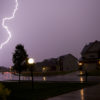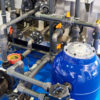When the swim season comes, and your pool gets heavy use, you will want it to be clean and safe for family and guests.
Pool Troopers can recommend some basic pool cleaning equipment that can be used daily to keep the water environment clean and healthy. Daily maintenance and testing can save you large amounts of money spent on repairs as well as chemicals. Here is some basic equipment that you will need:
Tele pole
A telescopic pole is the first thing that is necessary for daily cleaning. It is the basic tool for vacuuming, brushing and skimming. These poles are made from fiberglass or aluminum and come in a variety of lengths. Two or three poles are nested and locked in place to form a long pole. At the attachment side, a butterfly clip accepts the attached tool, such as a brush, vacuum head or skimmer net.
Skimmers and Leaf Rakes
The skimmer net or leaf rake attaches to the tele pole and is an important addition to your cleaning equipment. The net should be run along the water daily to collect unwanted floating objects. You can do this daily cleaning routine while enjoying the water, or from the outside perimeter.
A deep leaf net is meant to gather debris from the bottom of the pool and should be used an hour before pool use or vacuuming. Organic debris should not be allowed to accumulate in the pool. Excess debris creates a constant chlorine demand and uses up chemicals that should be present in the water to protect swimmers and remove harmful pathogens and organisms.
Testing Kit
If the pool receives heavy use or it has rained, you will want to test the water on a daily basis, using a kit, otherwise, weekly testing is the norm. Test strips can show the total and free chlorine, pH, alkalinity, and hardness of the water to help you determine if there is a need for additional chemical treatment.
Specialty kits can test for Stabilizer level (Cyanuric Acid), and Phosphates. Thermometers are important too as warmer water will require more chemicals to maintain.
Tips for Daily Maintenance
-
-
- Check water level
- Check filter and pump for leaks, the air in the system, and filter pressure
- Check pH and chlorine
- Check and empty skimmer and pump baskets
- Check automatic pool cleaner if applicable
- Check surrounding gates and fences
-
Water level – just by looking at the surface, you can tell if the water level is too low or too high. Pool water should be halfway up the skimmer opening which is usually half way up the waterline tile. If it is too high, there will be a problem with the skimmers not skimming; water that is too low creates a problem where the skimmers begin to suck air.
A small submersible pump can help lower the water level, or most pools are plumbed in such a way as to let water out of the pool via valves- just be sure to reset them after letting water out!
Filter and Pumps – Check the filter pressure gauge to see that water is flowing through the filter correctly. Low pressure might indicate filled baskets or closed valves. Higher than normal pressure might mean something is wrong after the impeller, such as closed valves or a dirty filter. Listen to the sound of the pump to hear any noise that is unusual and if possible, check to see the manner in which the water is running through the pump. The pump and filter system should be running from 8 to 12 hours a day and perhaps more in extreme heat conditions like the desert southwest or with heated pools.
Chlorine and pH – if you are testing daily you will know these levels. Otherwise, testing should be done two to three times per week. Maintain a level of 7.4 to 7.8 for pH; chlorine levels should be at least 2 to 4ppm with total chlorine and free chlorine being equal. If Total Chlorine is higher than free chlorine please consult a pool professional to help you, you have combined chlorine in the pool and need to address it before swimming resumes. This part of maintenance is worth the extra time it takes to test the water.
Baskets – check to see if the skimmer and pump baskets are full with debris or leaves or if the water is flowing correctly. Empty the baskets as needed to keep the suction strong. Also, check that the skimmer weir is correctly placed. Because algae can grow with poor circulation, water should be flowing freely. Make sure you are comfortable turning your pool system off and relieving the pressure from the system before you attempt to clean your pump’s basket.
Checking the automatic pool cleaner or robotic cleaner – unless the circulation is poor, you will only need to run the cleaner one to three times per week, usually not on a daily basis.
If you don’t have an APC or a Robotic cleaner you will need to have a pool vacuum head, which attaches to the tele pole, and a vacuum hose to properly vacuum the floor of your pool. This should be done regularly during swim season and at least monthly during the offseason.
Surrounding fences and gates – make sure that the gates are latched and that the fencing is strong and sturdy. Fill in, with additional dirt, any spots under the fence that could be used by a child or animal to access the area. Items near the fence should be moved, so there is no temptation to climb over the fence.
Remove toys after use – all toys should be removed daily to prevent a child from accessing the area or water because of the attraction of their colorful or favorite toys.
If your daily maintenance with basic equipment and water know-how brings up questions or concerns, give us a call at Pool Troopers to help you with any problems. You can also schedule weekly maintenance. We want to help you keep a healthy and safe environment for your family and friends. With some basic cleaning equipment and our contact information, you should be ready to have fun in a safe and clean swimming environment.




